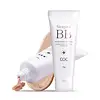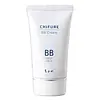What's inside
What's inside
 Key Ingredients
Key Ingredients

 Benefits
Benefits

 Concerns
Concerns

 Ingredients Side-by-side
Ingredients Side-by-side

Water
Skin ConditioningTitanium Dioxide
Cosmetic ColorantCyclopentasiloxane
EmollientCyclohexasiloxane
EmollientGlycerin
HumectantMethyl Methacrylate Crosspolymer
Dimethicone
EmollientButylene Glycol
HumectantDimethicone/Vinyl Dimethicone Crosspolymer
Skin ConditioningPhenyl Trimethicone
Skin ConditioningNiacinamide
SmoothingPolyglyceryl-3 Polydimethylsiloxyethyl Dimethicone
Skin ConditioningButylene Glycol Dicaprylate/Dicaprate
EmollientSodium Chloride
MaskingTrehalose
HumectantDisteardimonium Hectorite
StabilisingSorbitan Sesquioleate
EmulsifyingTocopheryl Acetate
AntioxidantSimmondsia Chinensis Seed Oil
EmollientMacadamia Ternifolia Seed Oil
EmollientScutellaria Baicalensis Extract
AntimicrobialIllicium Verum Fruit Extract
PerfumingTocopherol
AntioxidantCI 77492
Cosmetic ColorantCI 77491
Cosmetic ColorantCI 77499
Cosmetic ColorantTriethoxycaprylylsilane
1,2-Hexanediol
Skin ConditioningAllantoin
Skin ConditioningBetaine
HumectantAdenosine
Skin ConditioningDisodium EDTA
Acetyl Hexapeptide-8
HumectantSh-Oligopeptide-1
Skin ConditioningSodium Hyaluronate
HumectantCentella Asiatica Extract
CleansingWater, Titanium Dioxide, Cyclopentasiloxane, Cyclohexasiloxane, Glycerin, Methyl Methacrylate Crosspolymer, Dimethicone, Butylene Glycol, Dimethicone/Vinyl Dimethicone Crosspolymer, Phenyl Trimethicone, Niacinamide, Polyglyceryl-3 Polydimethylsiloxyethyl Dimethicone, Butylene Glycol Dicaprylate/Dicaprate, Sodium Chloride, Trehalose, Disteardimonium Hectorite, Sorbitan Sesquioleate, Tocopheryl Acetate, Simmondsia Chinensis Seed Oil, Macadamia Ternifolia Seed Oil, Scutellaria Baicalensis Extract, Illicium Verum Fruit Extract, Tocopherol, CI 77492, CI 77491, CI 77499, Triethoxycaprylylsilane, 1,2-Hexanediol, Allantoin, Betaine, Adenosine, Disodium EDTA, Acetyl Hexapeptide-8, Sh-Oligopeptide-1, Sodium Hyaluronate, Centella Asiatica Extract
Water
Skin ConditioningCyclopentasiloxane
EmollientButylene Glycol
HumectantTriethylhexanoin
MaskingDimethicone
EmollientNeopentyl Glycol Dicaprate
EmollientZinc Oxide
Cosmetic ColorantPEG-9 Dimethicone
Skin ConditioningPEG-9 Polydimethylsiloxyethyl Dimethicone
EmulsifyingNylon-12
Disteardimonium Hectorite
StabilisingDimethicone/PEG-10/15 Crosspolymer
Aluminum Hydroxide
EmollientAcrylates/Dimethicone Copolymer
Skin ConditioningHydrogen Dimethicone
Dimethicone/Vinyl Dimethicone Crosspolymer
Skin ConditioningPolyglyceryl-3 Polydimethylsiloxyethyl Dimethicone
Skin ConditioningSilica
AbrasiveSodium Citrate
BufferingMethylparaben
PreservativeHydrogen Dimethicone/Octyl Silsesquioxane Copolymer
Tocopherol
AntioxidantDipotassium Glycyrrhizate
HumectantDisodium Stearoyl Glutamate
CleansingPropylparaben
PreservativeTrehalose
HumectantDipropylene Glycol
HumectantSodium Hyaluronate
HumectantPEG-10 Dimethicone
Skin ConditioningSodium Acetylated Hyaluronate
HumectantTriethoxycaprylylsilane
Scutellaria Baicalensis Root Extract
AstringentTitanium Dioxide
Cosmetic ColorantIron Oxides
Water, Cyclopentasiloxane, Butylene Glycol, Triethylhexanoin, Dimethicone, Neopentyl Glycol Dicaprate, Zinc Oxide, PEG-9 Dimethicone, PEG-9 Polydimethylsiloxyethyl Dimethicone, Nylon-12, Disteardimonium Hectorite, Dimethicone/PEG-10/15 Crosspolymer, Aluminum Hydroxide, Acrylates/Dimethicone Copolymer, Hydrogen Dimethicone, Dimethicone/Vinyl Dimethicone Crosspolymer, Polyglyceryl-3 Polydimethylsiloxyethyl Dimethicone, Silica, Sodium Citrate, Methylparaben, Hydrogen Dimethicone/Octyl Silsesquioxane Copolymer, Tocopherol, Dipotassium Glycyrrhizate, Disodium Stearoyl Glutamate, Propylparaben, Trehalose, Dipropylene Glycol, Sodium Hyaluronate, PEG-10 Dimethicone, Sodium Acetylated Hyaluronate, Triethoxycaprylylsilane, Scutellaria Baicalensis Root Extract, Titanium Dioxide, Iron Oxides
Ingredients Explained
These ingredients are found in both products.
Ingredients higher up in an ingredient list are typically present in a larger amount.
Butylene Glycol (or BG) is used within cosmetic products for a few different reasons:
Overall, Butylene Glycol is a safe and well-rounded ingredient that works well with other ingredients.
Though this ingredient works well with most skin types, some people with sensitive skin may experience a reaction such as allergic rashes, closed comedones, or itchiness.
Learn more about Butylene GlycolCyclopentasiloxane, or D5, is a silicone used to improve texture of products and trap moisture.
D5 is considered lightweight and volatile. Volatile means it evaporates quickly after application. Once evaporated, D5 leaves a thin barrier that helps keep skin hydrated.
It is also an emollient. Emollients help soften the skin and prevent water loss. Silicones create a silky texture in products. D5 helps other ingredients become more spreadable.
Studies show D5 is safe to use in skincare products. We recommend speaking with a skincare professional if you have concerns.
Learn more about CyclopentasiloxaneDimethicone is a type of synthetic silicone created from natural materials such as quartz.
What it does:
Dimethicone comes in different viscosities:
Depending on the viscosity, dimethicone has different properties.
Ingredients lists don't always show which type is used, so we recommend reaching out to the brand if you have questions about the viscosity.
This ingredient is unlikely to cause irritation because it does not get absorbed into skin. However, people with silicone allergies should be careful about using this ingredient.
Note: Dimethicone may contribute to pilling. This is because it is not oil or water soluble, so pilling may occur when layered with products. When mixed with heavy oils in a formula, the outcome is also quite greasy.
Learn more about DimethiconeThis ingredient is a silicone used to improve the texture of products and absorb oil. It does not get absorbed into the skin.
Like other silicones, Dimethicone/Vinyl Dimethicone Crosspolymer helps condition the skin by creating a barrier. In this sense, it can act as an emollient and trap moisture in.
This ingredient is a type of elastomer.
Learn more about Dimethicone/Vinyl Dimethicone CrosspolymerDisteardimonium Hectorite comes from the clay mineral named hectorite. It is used to add thickness to a product.
It can also help stabilize a product by helping to disperse other ingredients.
Hectorite is a rare, white clay mineral.
Learn more about Disteardimonium HectoritePolyglyceryl-3 Polydimethylsiloxyethyl Dimethicone is a type of silicone.
Sodium Hyaluronate is hyaluronic acid's salt form. It is commonly derived from the sodium salt of hyaluronic acid.
Like hyaluronic acid, it is great at holding water and acts as a humectant. This makes it a great skin hydrating ingredient.
Sodium Hyaluronate is naturally occurring in our bodies and is mostly found in eye fluid and joints.
These are some other common types of Hyaluronic Acid:
Learn more about Sodium HyaluronateTitanium dioxide is a mineral UV filter widely used in sunscreens and cosmetics.
It is one of only two UV filters officially classified as “mineral” by regulatory agencies, the other being zinc oxide.
Titanium dioxide provides broad-spectrum protection mostly in the UVB and UVAII range, with some protection in the UVAI range.
While its UVA protection isn’t as strong as zinc oxide’s, the difference is minor.
A common myth is that mineral UV filters reflect UV light. However, modern research shows titanium dioxide absorbs UV radiation like chemical filters (~95% absorption & 5% reflection).
Thanks to its non-irritating nature, titanium dioxide is suitable for sensitive, acne-prone, or redness-prone skin. It is unlikely to cause "eye sting" like other sunscreen ingredients.
A major drawback of this ingredient is its white cast and thick texture. This is why mineral sunscreens often leave a white cast and are less cosmetically elegant than chemical/hybrid sunscreens.
To improve white cast and spreadability, micronized or nano-sized titanium dioxide is often used.
There are ongoing concerns surrounding nano-titanium oxide's impact on marine ecosystems.
There is no conclusive evidence that any form of titanium oxide (or any other sunscreen ingredients) will cause harm to marine ecosystems or coral reefs. The science is still developing but many consumers are keeping a close eye on this issue.
Please note, many destinations have reef-safety sunscreen rules. For instance, the U.S. Virgin Islands advises all visitors to use non-nano mineral sunscreens.
Nano mineral sunscreens once raised safety concerns about absorption into skin.
Extensive research has shown that they do not penetrate healthy or damaged skin; they remain safely on the surface and the top layer of dead skin (stratum corneum).
You'll likely find titanium dioxide bundled with alumina, silica, or dimethicone. These ingredients help make titanium dioxide highly photostable; this prevents it from interacting with other formula components under UV light.
Learn more about Titanium DioxideTocopherol (also known as Vitamin E) is a common antioxidant used to help protect the skin from free-radicals and strengthen the skin barrier. It's also fat soluble - this means our skin is great at absorbing it.
Vitamin E also helps keep your natural skin lipids healthy. Your lipid skin barrier naturally consists of lipids, ceramides, and fatty acids. Vitamin E offers extra protection for your skin’s lipid barrier, keeping your skin healthy and nourished.
Another benefit is a bit of UV protection. Vitamin E helps reduce the damage caused by UVB rays. (It should not replace your sunscreen). Combining it with Vitamin C can decrease sunburned cells and hyperpigmentation after UV exposure.
You might have noticed Vitamin E + C often paired together. This is because it is great at stabilizing Vitamin C. Using the two together helps increase the effectiveness of both ingredients.
There are often claims that Vitamin E can reduce/prevent scarring, but these claims haven't been confirmed by scientific research.
Learn more about TocopherolTrehalose is a disaccharide made of two glucose molecules (glucose is sugar!). Trehalose is used to help moisturize skin. It also has antioxidant properties.
As a humectant, trehalose helps draw moisture from the air to your skin. This helps keep your skin hydrated.
Due to its antioxidant properties, trehalose may help with signs of aging. Antioxidants help fight free-radical molecules, unstable molecules that may damage your skin.
In medicine, trehalose and hyaluronic acid are used to help treat dry eyes.
Some animals, plants, and bacteria create trehalose as a source of energy to survive freeze or lack of water.
Learn more about TrehaloseTriethoxycaprylylsilane is a silicone used to bind and stabilize ingredients.
As an emulsifier, it helps prevent ingredients from separating. This can help elongate the shelf life of products.
Triethoxycaprylylsilane is often used to coat mineral sunscreens ingredients to help give a better feel. It also helps reduce oxidative stress in sunscreens.
Learn more about TriethoxycaprylylsilaneWater. It's the most common cosmetic ingredient of all. You'll usually see it at the top of ingredient lists, meaning that it makes up the largest part of the product.
So why is it so popular? Water most often acts as a solvent - this means that it helps dissolve other ingredients into the formulation.
You'll also recognize water as that liquid we all need to stay alive. If you see this, drink a glass of water. Stay hydrated!
Learn more about Water